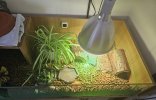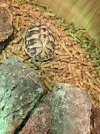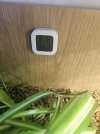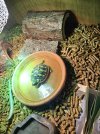OnHisShellHeHoldsTheEarth
New Member
Hi everyone! I recently bought a Hermann tortoise (hatched Nov-23) from an experienced, licenced seller and I have followed the care sheets provided, the tortoise seems happy and healthy. I posted a photo of Shelly on a social media channel and it seemed to have picked up a bit of attention from others telling me that the Repti-turf substrate is not suitable, the tortoise looks dry and is pyramiding, which I don't believe is true as I bathe and provide clean water daily. I currently have Shelly in an open top table, when the weather is warm enough outside I have put them outside in a safe enclosure but have only done this on very warm days. For info I am in the UK. I have added photos of the set up and photos of Shelly. I would appreciate some advice as I want to provide the best care for my pet.  Thanks!
Thanks!
 Thanks!
Thanks!



